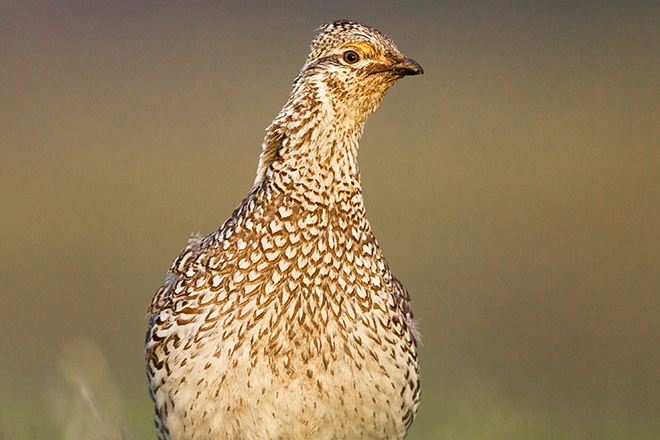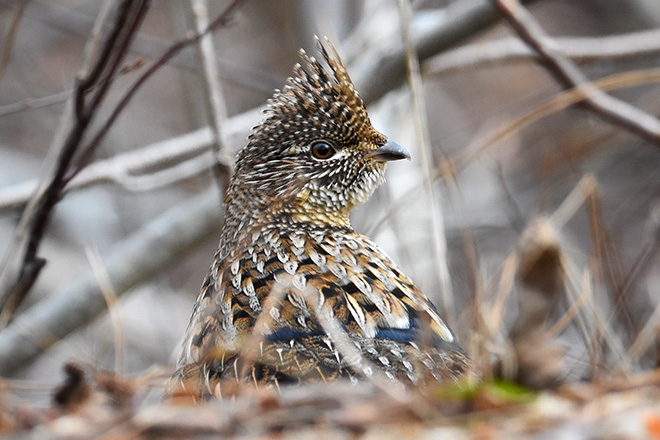My Last Day is for Sharptails
By Anthony Hauck
If I had one last earthly day to hunt?
Hmmm. That’s a tough one. I suppose it would go something like this. I would drive west through a few dots on the map until a place where the dots and then the blacktop end.
Once on gravel, I’d spy a buck mule deer next to an abandoned farmstead, with antlers so big you’d have to rub your eyes just to make certain your mind isn’t fusing the burr oaks behind him.
To shake the night and the cool off, I’d climb hills to meet the rising sun. The spaniel doing the same would beat me to it
A covey of grouse would do a fly-by, settling in three ridges and three swales over. With every inch as far as the eye can see open to me, the only consideration would be when we want to get there.
Because we’d have all day, and also because my wild plum spot would be in desperate need of checking, we’d choose the long way. I’d fill an empty vest pouch with a dozen or so “for the road.”
Near the bushes, we’d jump a jackrabbit. I’ve found they’re luckier with all four feet attached.
We’ll find those grouse, getting frustratingly close enough to push them three ridges and three swales over. It would be okay — you don’t want your final hunt to end too early.
To shake the heat off, we’d take refuge under a relic of a cottonwood. I’d eat a peanut butter and jelly sandwich — saving the crust for the never-not-hungry spaniel — and a handful of those wild plums. My field hat would slip down over my eyes, inducing the kind of dream sleep where one ponders such things as final meals and last hunts.

Shutterstock Image
Peeking under the lid, I’d catch the spaniel in a gentle gaze, a breeze rustling her ears and giving her nose scents to sort out. Even she would know that every once in a while you have to stop and smell the wild sunflowers.
Slipping through a winding bottom, the spaniel would leave no silver buffaloberry unturned. Her meticulousness would finally be rewarded.
Even with a bird in hand, we’re still on the lookout for our covey, which would flush wild at the end of the draw, moving three ridges and three swales over. We’d be going that direction anyway, so it’s all the same.
Near the last known grouse hideout, we’d find a deer skull. I suppose it would make a fine mount in an office or study but seems better left amidst its tangle of late summer grass. I could only hope his last meal was wild plums.
Just when you think we’d be flagging, we’d glide over the next two hills. This is the essence of sharptail country: Simply being unfettered is enough to fuel us.
With the sun starting to hang, the spaniel would finally catch up to our covey. On its rise, I’d pick the rightmost bird, eyes and gun glued on him until enough horizon crept in below. On the shotgun’s report, I’d steal a glimpse of the group’s dawdler going out the back door. I’d have shot skeet for three consecutive months, and this would be the chance to put all that practice into performance. I would.
The spaniel would retrieve both birds, earning a heaping helping of praise. I’d think about snapping a photo, but then remember that I once read taking photos messes with one’s memory of the moment. So I’d decide not to fuss with it, and instead lock onto the spaniel’s eyes, searing the moment irrevocably to my soul, so that nothing —not age, dementia, space or time — could ever pry it from that place.
Measured in her years, the spaniel and I have spent 70 together, so by now I would know “limit” is not a word in her vocabulary. I’d simply cut her loose again to hunt some more.
With empty gun broken over my shoulder, I’d watch her every move.
Measured in miles, it would be a very long walk back to the truck. But going by meadowlarks and mule deer, it would go by all too quickly.
On the climb to the big plateau, the air would stratify, an autumn mist filling the coulee below. At the top, summer Venus would greet us with her evening gleam from the western sky.
When you love someone, you have to tell them, so I call the spaniel in and do just that.
Come to think of it, if I had one last day of hunting, it would go exactly like today.
And if we make it through the night, we’ll do it again tomorrow.
Anthony Hauck walks all manner of uplands behind his little field-bred English cockers, but sharptail country beckons loudest … until pheasant season begins.
A Solitary Pursuit
By Matt Soberg
Think about something that you truly love in life. Maybe you read a classic book to relax before bed. Maybe you play catch with your son in the front yard on a sunny summer day. Maybe you sit in the boat with a beer to watch bobbers gently float on the lake.
If you could pick one thing that makes you most fulfilled, what would it be?
Next, think about why you love it so much. How does it exemplify your true passions in life? How do the feelings bring you back for more? These attributes identify the ultimate nature of an experience for what it is. This culmination is the true essence of an activity that defines meaning in our lives.
For me, I live to hunt ruffed grouse in the Northwoods in a solitary pursuit. I learned this from my father and grandfather before him, and hope these traditions will continue to trickle down through future generations of hunters after me.
My grandfather was as Norse as a man could get. He started a construction company quite young and scratched out a living for his family. True to his Scandinavian roots, he would don a red-plaid jacket and floppy-eared hat every Saturday afternoon to hunt the Northwoods when the weather was right. He’d open the shotgun seat of the trusty, rusty red Ford truck for the bird dog, and off they’d go for a day’s solitary pursuit of wild game.
Whether the quarry was ruffed grouse, waterfowl or whitetails, the food made a difference for the family, especially in those long Minnesota winter months when outside construction jobs were hard to come by.
Before my father was old enough, my grandfather always hunted alone. Those Saturdays in the forests were nearly religious. Unfortunately, my grandfather is no longer with us, but I have heard a multitude of special stories around the campfire from generations carrying on his legacy.
Fast forward multiple decades, and I, too, prefer an afternoon in a solitary pursuit. I always wondered why my grandfather hunted alone. Was it because he had to? Was it because he truly loved the chase? That same desire was bestowed upon me by blood, and through time alone in the woods myself, I learned the true essence of it all.

Shutterstock Image
October is too short, so I take an afternoon alone from everything in the world every chance I can. The short drive calms my mind from the worries of work as the dogs do the opposite, whimpering with heightened anticipation.
The trail greets a hunter with the open arms of oranges and reds of changing leaves on the branches hanging overhead. The dogs run with the athleticism and purpose that only the pure passion of instinct can muster. The birds are there … somewhere … hidden by the perils of thorns and ticks and miles of boot leather from the truck.
The only mission is to find the treasure that they bestow upon a discerning hunter willing to pursue the challenge.
The cadence of the dog bell sets the tone for the upland song with missed shots adding a hint of percussion to its melody. The silence inherent in the point sets the scene in slow motion that suspends time. Mind and body lock into focus on the dog’s location while maneuvering through the obstacles hindering the path. No being is as intense as a dog on point, and the moment’s gradual crescendo climaxes with the flush of the wily grouse in a mere blur of brown or gray in the distance.
The ultimate goal is for me to do my part with the shotgun in my hands. I am the first to admit that the harmony of the hunt results in more misses than hits, but I have held a grouse in hand a time or two. Considering the many pitfalls along the way, I can likewise admit that holding such a valiant creature is worth a precious fortune.
As an editor, I’d be a rich man if I had a nickel for every story I’ve read with prose that started something like this: “The golden coins of autumn fell to the ground as I walked the trail behind my bird dog…”
It is almost impossible to uniquely describe the beauty of October. I once made fun of this phenomenon because it happened so often. But as I grow old, I have come to appreciate the sentiment for what it is. The golden coins are just as much part of the fortune of grouse hunting as the beautiful habitat and intense dogs and wild birds that together create the experience that I hold so dear.
I now know why my grandfather treasured the solitary pursuit. I now know why I do too. A hunt for ruffed grouse in the Northwoods may be solo in nature … but is far from it in its true essence. A grouse in hand is full of fortune, and we are never truly alone in the search.
Matt Soberg is easily lured out of the office and into the grouse woods of central Minnesota for October afternoons of solitary pursuit.